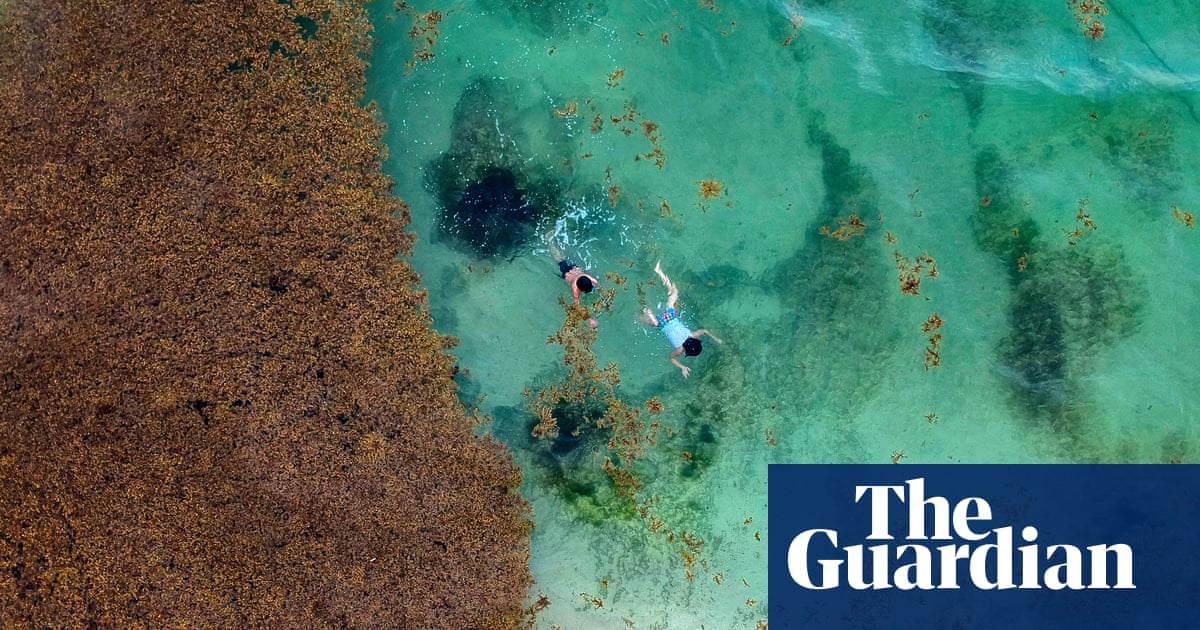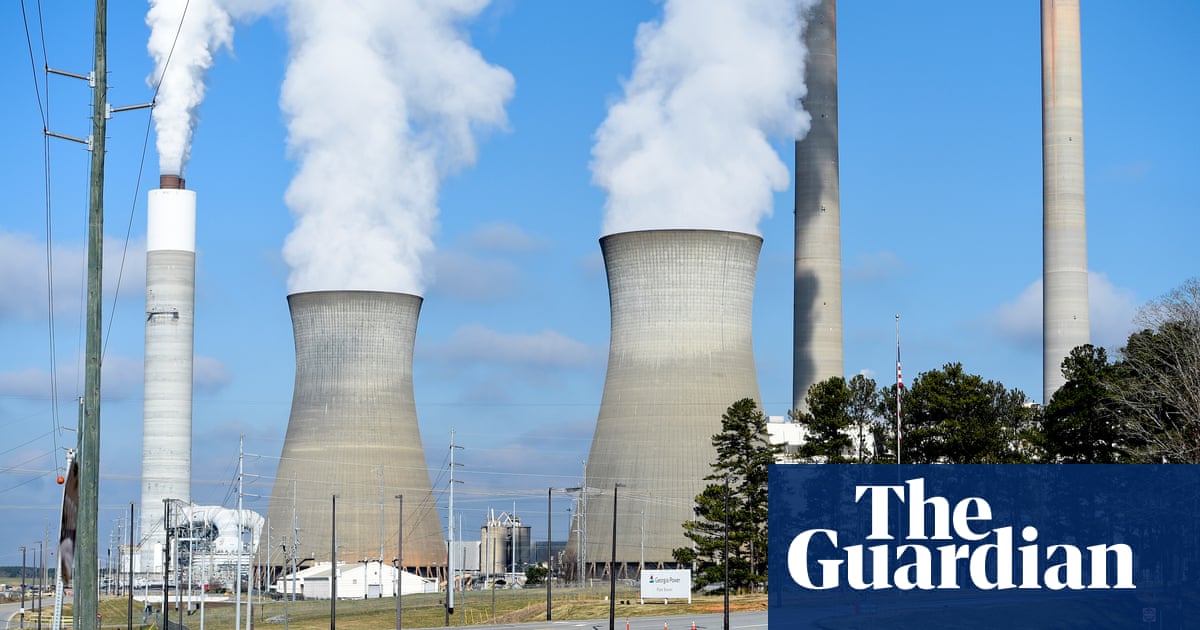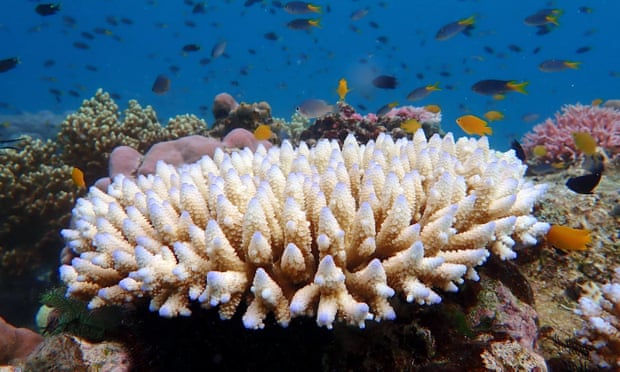Schools evacuated due to toxic gas. Smelly tap water at home. Tourist operators and fishers struggling to stay in business. Job losses. Power outages affecting tens of thousands of people at a time. Dangerous health problems. Even lives lost.
Such crises were some of the consequences of sargassum seaweed in the islands of the Caribbean in 2023, which have become common in the region since 2011, when massive blooms began inundating the shorelines in the spring and summer months.
On 18 April 2023 in Guadeloupe, the air-quality monitoring agency Gwad’Air advised vulnerable people to leave some areas because of toxic levels of gas produced by sargassum. Six weeks later, about 600 miles to the north-west, it blocked an intake pipe at an electricity plant at Punta Catalina in the Dominican Republic. One of the facility’s units was forced to temporarily shut down, and a 20-year-old diver named Elías Poling later drowned while trying to fix the problem.
In Jamaica, during the months of July and August, fishers found themselves struggling through another season as floating sargassum blocked their small boats and diminished their catch.
“Sometimes, the boats can’t even come into the creek,” said Richard Osbourne, a Jamaican fisher. “It blocks the whole channel.”
In the British Virgin Islands (BVI), most of Virgin Gorda’s 4,000 residents had to deal with sporadic water shut-offs and odorous tap water for weeks after sargassum was sucked into their main desalination plant last August.
And in Puerto Rico, a highly unusual late-season influx inundated the beaches of the Aguadilla area for the first time, leaving residents such as Christian Natal out of work for a week when it shut down businesses, including the jetski rental company where he works.
These people were among the thousands affected by sargassum blooms last year alone in the Caribbean, where about 70% of the population of about 44 million lives near the coast, according to the World Bank.
Scientists have blamed the explosive growth of the seaweed on global pollution, climate breakdown and other international problems that Caribbean islands did little to cause and lack the political power to resolve.
“Seaweed must be seen as an impact of global warming, with the opening up of the right to compensation on the grounds that we are small, vulnerable islands,” said Sylvie Gustave-dit-Duflo, the vice-president of the Guadeloupe region in charge of environmental issues and president of the French Biodiversity Office.
She added that the countries of the Caribbean Community (Caricom) – which include 15 member states and five associate members that are territories or colonies – recorded economic losses of about $102m due to sargassum in 2022 alone.
“These figures do not take into account the losses recorded in all the other Caribbean countries, including the French islands,” she said. Nor do they take into account yearly costs of beach cleaning estimated to be as high as an additional $210m.
Gustave-dit-Duflo and other experts say the global problem requires a global response. But so far, the Caribbean has failed to coordinate even a region-wide strategy and the international community has largely turned a blind eye. National-level responses, which in most Caribbean countries include a draft management strategy that has not been officially adopted or adequately funded, have done little to take up the slack.
Most sargassum influxes are predictable, and the worst impacts are often preventable. But again and again Caribbean governments have waited to react until the crisis stage. And even then the responses have often focused on protecting the tourism industry while other groups, such as local communities or fishers, are left behind.
As a result, the health, livelihoods and natural environment of residents have been endangered, and hundreds of millions of dollars have been spent on reactive emergency responses that experts said could have been better spent on prevention, planning and mitigation.
At the conference of the parties to the UN framework convention on climate change (Cop28) last December in Dubai, Gustave-dit-Duflo helped to unveil a French proposal for the sort of international response she said was urgently needed. It included forming a global coalition to better understand the problem, ensuring that sargassum is on the agenda of major international forums, and continuing previous work in partnership with the EU, among other measures.
But to implement the proposal, governments in the Caribbean and further abroad will have to overcome hurdles that have previously stymied cooperation, including political and legislative differences, funding shortages and debate about whether to prioritise health, the environment, the economy or other areas.
In the meantime, sargassum has already started to arrive on the Caribbean’s shores once again. And once again, the region is not ready.
The ‘great Atlantic sargassum belt’
Sargassum is not a bad thing in itself. Nor is it new to the Caribbean, where it has always washed ashore in modest quantities in the spring and summer, providing habitat for marine life and helping build beaches as it decays.
But in 2011 sargassum suddenly swamped shorelines without warning. It piled several feet high on some beaches. It stank like rotten eggs as it decomposed and shut down resorts, dealing a major blow to a tourism sector in some areas of the Caribbean that were still struggling to recover from the 2008-2009 global recession. It gave coastal residents headaches, nausea and respiratory problems. It disrupted turtle nesting sites and threatened reefs and mangroves.
As sargassum continued to flood the Caribbean and the western coast of Africa 8,000 miles away, scientists made a surprising discovery. Historically, most of the seasonal influx in the Caribbean had come from a 2-million-square-mile gyre in the northern Atlantic Ocean: the Sargasso Sea.
“The Sargasso [Sea] has been around for hundreds of thousands of years, and it’s an ecosystem that was perfect, so to speak,” said Elena Martínez, an oceanographer based in the Dominican Republic. “It was there, surrounded by four oceans gyres – or currents – that kept it perfect.”
But scientists soon learned that most of the new Caribbean influx was not coming from the Sargasso Sea any more: it was coming from a new sargassum ecosystem that had formed in the southern Atlantic Ocean.
The area, named “the great Atlantic sargassum belt” in a 2019 article in Science is now visible from space, and its length often exceeds 5,000 miles, according to scientists who use satellites to track it.
Its cause is still debated. Dr Brian Lapointe, a sargassum researcher, sees the Atlantic belt as a global version of a smaller bloom he witnessed in 1991 that shut down a nuclear power plant and other electricity facilities along the Florida coast.
Since the 1980s the world population has nearly doubled, explained Lapointe, a professor at Florida Atlantic University. This in turn has led to a massive increase in the sargassum-boosting nutrients washing out of major rivers such as the Mississippi in the US, the Amazon and Orinoco in South America, and the Congo in Africa.
“To grow that world population we’ve used these fertilisers, we’ve deforested along all the major rivers in the world,” he said. “The nitrogen has gone up faster than the phosphorus from all these human activities, including wastewater; sewage from the increasing human population.”
Another likely culprit is climate breakdown. Martínez said warming waters may have disrupted the giant gyre that held the Sargasso Sea in place for thousands of years, releasing sargassum to float south and form the new belt.
after newsletter promotion
The new belt also receives additional nutrients from the Sahara dust that frequently blows across the Atlantic, which itself could be exacerbated by climate impacts such as the expansion of deserts as temperatures rise. Some scientists also argue that warming oceans provide a more sargassum-friendly growing environment.
Experts tend to agree that the great Atlantic sargassum belt is here to stay – and that it is a global problem that needs a global response.
That much was clear by 2018, when the belt grew to a record size that was estimated to weigh 22m tonnes and much of the Caribbean saw its worst-ever inundation. The season spurred increasing calls for a collaborative international response.
But broad international action has not materialised. Despite a growing patchwork of studies and projects across the region, various attempts by the UN and others to coordinate a Caribbean-wide response have been largely stalled by funding shortages, geopolitical issues, the Covid-19 pandemic and other factors.
No Caribbean strategy is in place, and a region-wide warning and monitoring centre proposed in 2019 has not been established.
In 2022, the Saint Lucian sargassum researcher Dr Bethia Thomas produced videos about the village of Praslin Bay and two other nearby communities as part of her doctoral thesis. In each video, several residents listed complaints ranging from breathing problems to the destruction of fisheries to corroding jewellery.
“It affects how I breathe, and I also think it affects the children and the way that they function, because sometimes they’re so moody and they cannot sit and do the activities because it’s so awful,” a teacher said in the Praslin Bay video. “And I think it’s affecting us mentally.”
In the absence of a regional strategy, national sargassum management plans have been developed in most countries and territories in the Caribbean, including Saint Lucia, Barbados, Dominica, Grenada, Saint Vincent and the Grenadines, the BVI, Anguilla and Montserrat.
But few have been officially adopted at the government level, and even fewer are adequately funded or closely followed.
“Sometimes the small communities get left behind,” Thomas said. “Maybe not intentionally, but in small island developing states with limited resources, you have to prioritise. And perhaps other things – like building a new hospital and constructing new roads, new schools – might take precedence over developing a sargassum management plan.”
Negligible investment from polluting countries
As residents experience health and economic consequences, Caribbean leaders have often complained about a shortage of money to deal with the crisis. Local funds, they said, are tied up with many competing priorities, including handling climate-related impacts such as hurricanes, droughts and flooding.
They also said the cost of the sargassum crisis should be shouldered in part by the larger countries mostly responsible for it, but that accessing international climate financing for the purpose was not easy.
A lack of funding and regional coordination has also stymied efforts to monetise the seaweed by finding a large-scale sustainable use for it.
“Even though there are so many things you can make with sargassum, the actual amount of sargassum that is used for products is still very low,” said Dr Franziska Elmer, a researcher based in Mexico.
Sargassum and Cop28: invasion starts to garner attention
The 2023 sargassum bloom in the Caribbean had mostly abated by 2 December when Gustave-dit-Duflo stood at a podium 8,000 miles away during a side event at the Cop28 meeting in Dubai.
As dignitaries looked on, she issued a stark warning about sargassum. “It is a very invasive and aggressive phenomenon, and through all the Caribbean it affects tourism, and all the economies of the region are based on biodiversity and tourism,” she told those gathered at the French pavilion on the sidelines of the conference. “The Caribbean has a lot of hotspots of biodiversity. So if we don’t act, in 20 years this marine biology, including the reef, will disappear from our coast.”
She said the French government wanted the issue to be discussed on one of the high-level panels of the United Nations conference on the oceans to be held in Nice, France, in June 2025.
“We manage sargassum at a local level, but this is not a phenomenon of an island,” she said. “It is the whole basin of the Caribbean and a part of the Atlantic. This is why all the countries that are impacted, we need to create an international coalition to be able to find means and ways to act.”
As countries work to establish an international response, time is of the essence for residents of the coastal Caribbean.
Shortly after Cop28 drew to a close, scientists at the University of South Florida estimated the sargassum floating in the tropical Atlantic Ocean at about 5m metric tonnes, compared with a December average of about 2m. By February, the mass had increased to about 9m tonnes – the second-highest quantity ever recorded for the month.
In other words, another record-setting sargassum season could have just started.
-
This article, coordinated by the Puerto Rico Center for Investigative Journalism and produced by the BVI Beacon, RCI Group Guadeloupe, América Futura, El País América, Television Jamaica and the Virgin Islands Daily News, is published here as part of the global journalism collaboration Covering Climate Now. Reporters Rafael René Díaz Torres (Centro de Periodismo Investigativo), and Mariela Mejía (Diario Libre) collaborated in this investigation. This investigation is the result of a fellowship awarded by the Center for Investigative Journalism’s Training Institute and was made possible in part with the support of Open Society Foundations.




